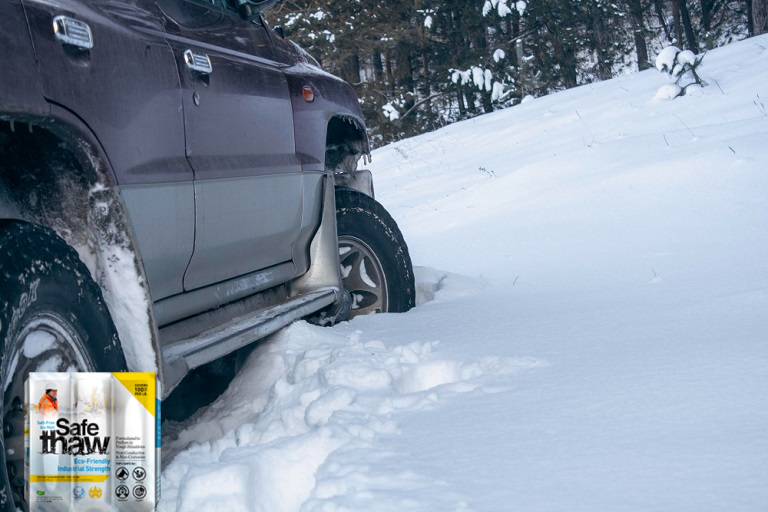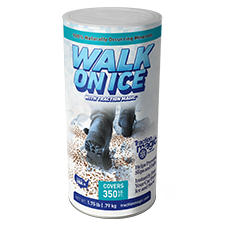What Is The Best Ice Melt For Pavers

There’s nothing like a winter walk to make you appreciate the elegance of a well-designed sidewalk or driveway. But what happens when that lovely stone becomes an icy mess? You need ice melt for pavers. This article will help you decide what is the best ice melt for pavers and how to use it so your stone surfaces stay safe as well as beautiful year round.
Can You Use Ice Melt on Pavers?
Yes, you can use ice melt on pavers, but the type of ice melt you choose is crucial. Some ice melt products, especially those based on rock salt (sodium chloride), can cause paver damage such as cracking and flaking. Thus, it’s essential to look for an ice melt safe for pavers.

Safe Thaw
Safe Thaw was created as the ice management solution for tough winter environments. Ideal in commercial and industrial properties, shops, government agencies, bridges, and construction.
Understanding the Impact of Ice Melt on Pavers
Pavers, whether concrete, brick, or stone, are a popular choice for driveways, walkways, and patios due to their durability and aesthetic appeal. However, icy conditions can make these surfaces dangerous. While many people instinctively reach for traditional ice melt products to manage this issue, not every product is safe for pavers.
What Is The Best Ice Melt For Pavers?
As you’ve probably noticed, there are many different brands of ice melt available on the market today. This can make it difficult to find a product that will meet your needs. Before you buy any product for your pavers, it is important that you consider what you need from an ice melt.
For example: If you have pets or children who may come into contact with the ice melt after application, look for something that won’t be harmful if they ingest it or get it on their skin (see below).
If your pavers are made from concrete, granite or other types of stone, look for products that will not stain them when applied.
Remove ice as soon as possible. Ice melts faster if you remove it right away, so make sure to shovel any snow off your pavers before it can refreeze into ice.
100% salt & chloride-free, fast acting Ice Management Solution
Don’t use sand or salt. When people try to melt the ice on their pavers with a mixture of salt and sand, they often end up making things worse: not only does this combination create an unsightly mess on your walkway, but it also damages your pavers’ surfaces over time. Instead, consider using Safe Thaw products that are specifically designed for melting ice without damaging them (and without leaving behind stains).
Consider using a snowblower to clear a path through thick snow drifts—this will keep you from having to shovel as much! Just remember: if there’s still daylight left in the day after you’ve cleared off the walkway by hand (or with machinery), don’t forget about ice patches farther down into your yard—they’ll melt too overnight!
When considering what kind of ice melt is safe for pavers, look for products specifically designed to be gentle on concrete and other hard surfaces. Safe Thaw stands out as the best ice melt for pavers, as it is a chemical-free, toxin-free ice melt that’s safe for concrete and property.
What Ice Melt Is Safe For Roofs?
Safe Thaw is a safe ice melt for roofs. Safe Thaw is a biodegradable ice melter that is made from volcanic residue ingredients, so you don’t have to worry about any unwanted residue on your roof. It’s also non-toxic and environmentally friendly, so you can feel good about using it around your home.
Practical Tips On How To Remove Tire Marks From Pavers
Once concrete surfaces are addressed, the next headache many people face is with pavers. So the question often comes up: how to remove tire marks from pavers without ruining their finish? Pavers, being more porous than sealed concrete, tend to absorb rubber residue quickly, making the marks stubborn. A good first step is using a stiff nylon brush with warm, soapy water. That alone can loosen light rubber transfer. For deeper stains, a diluted vinegar solution or an eco-friendly degreaser works effectively without altering the color of the pavers.
If you’re dealing with older, baked-in marks, a pressure washer can help—but the trick is not to overdo it. Too much pressure can etch the surface and cause uneven wear. That’s why short bursts at medium pressure are safer than a constant high-pressure blast. Regular cleaning with gentle methods keeps the problem from escalating into something that requires full resurfacing.
Choosing The Best Salt For Pavers And Safer Alternatives
Now, here’s where winter care collides with stain management. Many people wonder what’s the best salt for pavers when ice sets in. The hard truth? Traditional salts—like sodium chloride and calcium chloride—can seep into pavers, weaken their bond, and even cause discoloration over time. That’s why relying on “best salt” solutions is a bit of a trap; the better question is whether salt is the right option at all.
Instead of reaching for chloride-based products, which erode joints and surrounding soil, chloride-free solutions like Safe Thaw provide the same ice-melting effectiveness without compromising the integrity of the pavers. Because pavers rely heavily on joint sand for stability, using non-corrosive, salt-free options ensures you aren’t washing away their strength with each winter storm. By shifting the focus away from salt entirely, you protect both the appearance and the structure of your paved areas.
Eco-Friendly Deicing With Grass Safe Ice Melt
Another angle many overlook is the landscaping around paved driveways and sidewalks. Salt runoff can wreak havoc on grass, shrubs, and plants nearby. That’s why opting for grass safe ice melt makes all the difference. Traditional deicers increase soil salinity, making it harder for grass roots to absorb nutrients and water. Over a few seasons, this damage becomes obvious—yellow patches, thinning blades, and even bare spots.
Switching to a grass-safe, chloride-free formula eliminates this risk. Since products like Safe Thaw use non-toxic, non-corrosive compounds, they don’t leach harmful chlorides into the soil. This means you’re not trading safety on the driveway for damage in the garden. If you’ve invested in landscaping, a grass-safe option is not a luxury—it’s a necessity.
Why Sidewalk Safe Ice Melt Matters For Long-Term Safety
Pavers and driveways often steal the spotlight, but sidewalks demand equal attention. Using the wrong deicer here can cause surface flaking, joint damage, and unnecessary repairs. So what qualifies as a sidewalk safe ice melt? It comes down to two factors: surface safety and pedestrian safety.
Chloride-based products may clear ice quickly but leave behind slick brine or corrosive residue that damages footwear and etches surfaces. A sidewalk-safe melt should not only clear ice but also provide traction, reducing slip risks in high-traffic zones. That’s why chloride-free granules with traction agents are ideal—they melt ice while leaving behind a gritty surface for safer footing. With the right product, sidewalks remain clear, stable, and safe for employees, customers, or visitors throughout the season.
Conclusion
Concrete and pavers may look tough, but they’re far more vulnerable to stains, salt, and chemical stress than most realize. Learning how to remove tire marks from pavers prevents unsightly discoloration, while avoiding the so-called best salt for pavers ensures you’re not compromising their structural joints. Pairing these efforts with grass safe ice melt protects your landscaping, and choosing sidewalk safe ice melt preserves both the surface and pedestrian safety.
The real takeaway? Maintenance isn’t just about quick fixes—it’s about smart, preventative choices that keep every part of your property intact. By steering clear of harsh chloride-based products and adopting eco-conscious solutions, you safeguard pavers, sidewalks, and surrounding landscapes from long-term damage. With these strategies, your surfaces don’t just survive the winter; they emerge looking just as good when the snow clears.
FAQs
Try Also Our Other Winter Safety Products:
Safe Paw
The Original and #1 Selling Pet and Child Safe Ice Melt for over 20 years. Guaranteed environmentally safe –It won’t harm animals or children, and it won’t damage your property. That’s Safe Paw. Safe Paw can change how winter affects our planet.

Walk On Ice
The handy disposable canister can be taken everywhere, with the same 100% naturally occurring minerals that provide instant traction on ice or snow. Use it on sidewalks, steps, or as an instant traction agent for your car.



